When it comes to enhancing the safety and comfort of our loved ones as they age, selecting the right bed rails for seniors can be a crucial decision. These senior living amenities are not just about preventing falls; they are about facilitating independence and maintaining dignity. Whether you are a family member looking out for a relative or a caregiver seeking the best options, understanding the key factors that influence the choice of bed rails is vital. Here’s what you need to consider to make an informed decision.
Compatibility with the Bed
First and foremost, it’s crucial to ensure that they are compatible with the existing bed setup. Bed rails come in various designs and sizes, each suited for different bed types, including standard home beds, hospital beds and adjustable beds. Before making a purchase, measure the mattress’s thickness, the bed frame’s dimensions and any specific features like side padding or edge design.
It’s important to verify that the rails can be securely fastened to the bed’s frame, ensuring they remain stable underweight and moving. This compatibility not only affects installation but also impacts the effectiveness of the rails in preventing falls and injuries. Additionally, check for the ability to integrate with other bed accessories, such as bed covers or bumpers, which may be necessary for creating a comprehensive, safe sleep environment for the resident.
Ease of Installation and Use
The ease of installation and the usability of bed rails are pivotal factors that significantly affect their practicality and effectiveness. Opt for products that come with all necessary components and straightforward instructions to facilitate quick and hassle-free setup. The ideal bed rail should be lightweight yet durable, allowing for easy adjustments and repositioning by caregivers or family members as needed.
Furthermore, consider the daily use of the rails from the perspective of the resident. They should be able to operate the rails comfortably, such as lowering or adjusting them without assistance, which promotes independence and confidence. Rails that are complex to handle can lead to frustration and may even discourage the use of potentially beneficial safety features. Additionally, removable or retractable rails can offer flexibility, accommodating different levels of mobility and changing needs over time.
Safety Features
Safety is the paramount concern when choosing bed rails for seniors. Quality rails should be constructed from durable, non-toxic materials that withstand regular use without compromising structural integrity. It’s crucial to ensure there are no sharp edges or small parts that could cause injury. The design should also prevent entrapment; gaps between bars must be narrow enough to prevent limbs from getting stuck, which could lead to serious injuries.
For added safety, look for rails with padding or made from mesh materials to prevent direct contact with hard surfaces. Additionally, secure locking mechanisms are essential. They should be robust yet easy for caregivers to operate, preventing accidental adjustments or releases.
Adjustability and Flexibility
The best bed rails for seniors offer adjustability in terms of height and length to accommodate various needs and bed sizes. Adjustable rails can be customized to suit the specific requirements of the resident, whether they need minimal restraint or more extensive boundaries. Some models also offer a swing-down feature, which allows the rails to be lowered easily, making it simpler for residents to get in and out of bed and for team members to assist.
Resident’s Mobility Level
Consider the mobility level of the resident when choosing bed rails. For those who are relatively active and need minimal support, smaller, less restrictive rails might be adequate. However, for residents with significant mobility challenges or those at higher risk of falling, more extensive rail options might be necessary. It’s also worth considering how the rails can support the use of mobility aids, like walkers or wheelchairs, near the bed.
Aesthetic and Comfort Considerations
Lastly, consider the aesthetic aspects and the comfort level provided by the bed rails. While functionality and safety are the primary concerns, it’s also important that the rails don’t make the bedroom feel too clinical. Look for options that blend in well with home decor and maintain a warm, inviting atmosphere. Comfort is also crucial, as the rails should not disrupt the resident’s sleep or cause discomfort while resting.
Choosing the right bed rails involves more than just picking a safety accessory; it’s about enhancing the living environment of our loved ones to support their independence and well-being. For those looking for a comprehensive approach to safety and comfort, a retirement community might be the perfect setting to help residents live with better health and well-being in their golden years.






